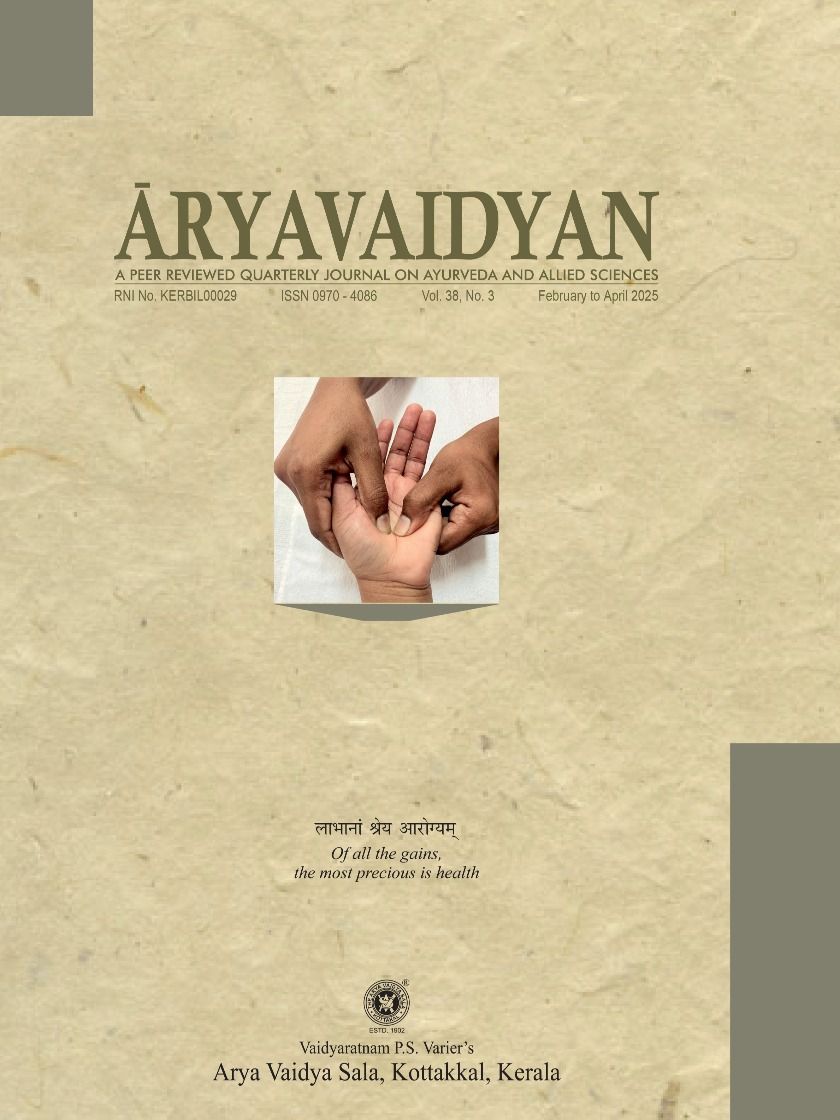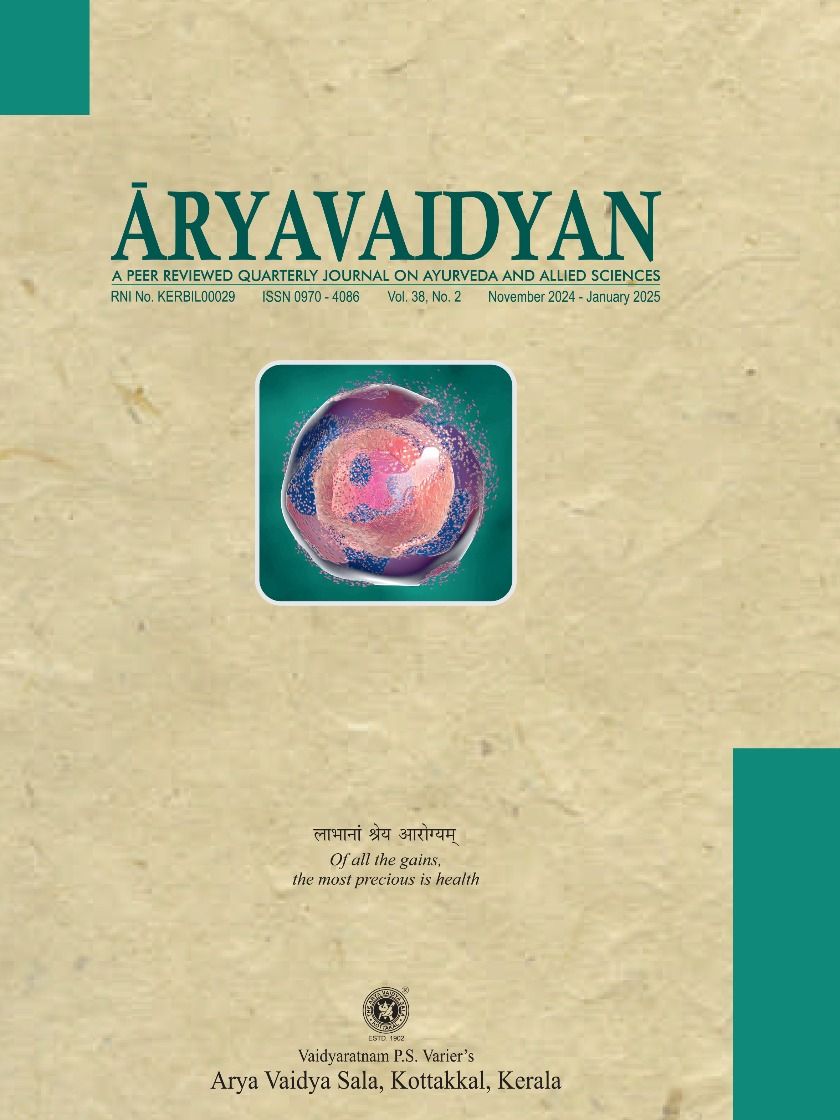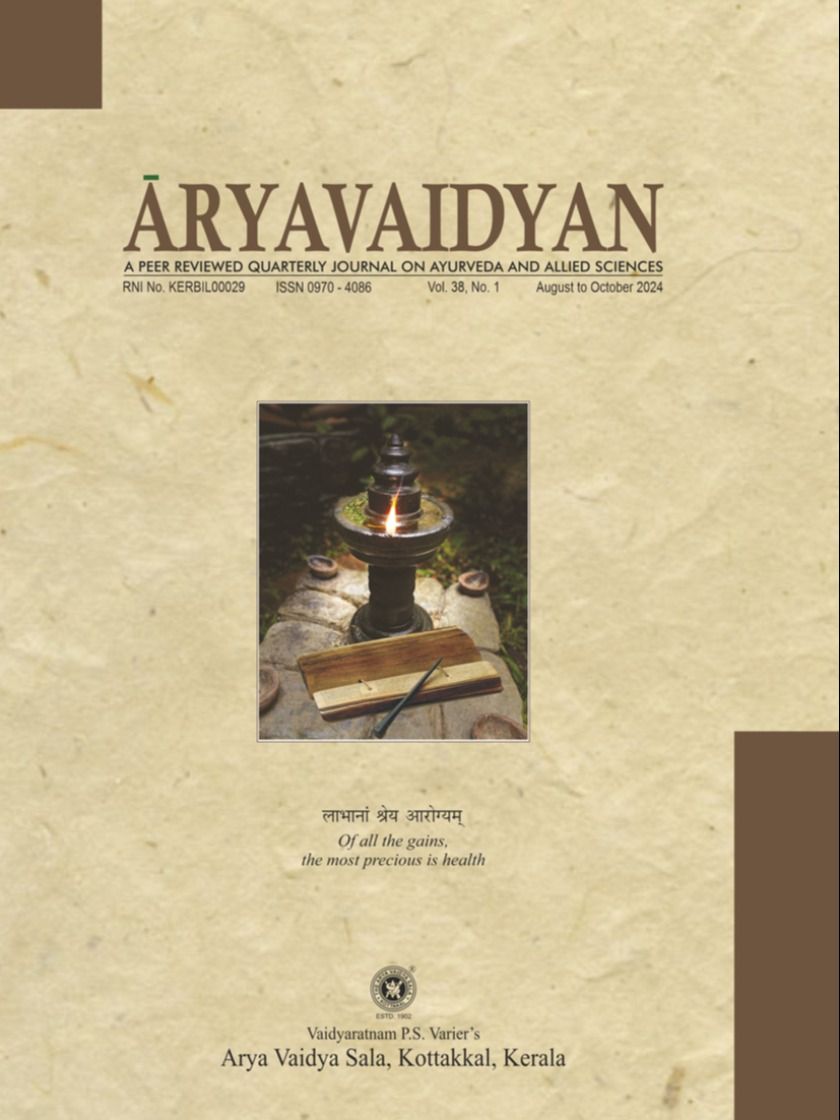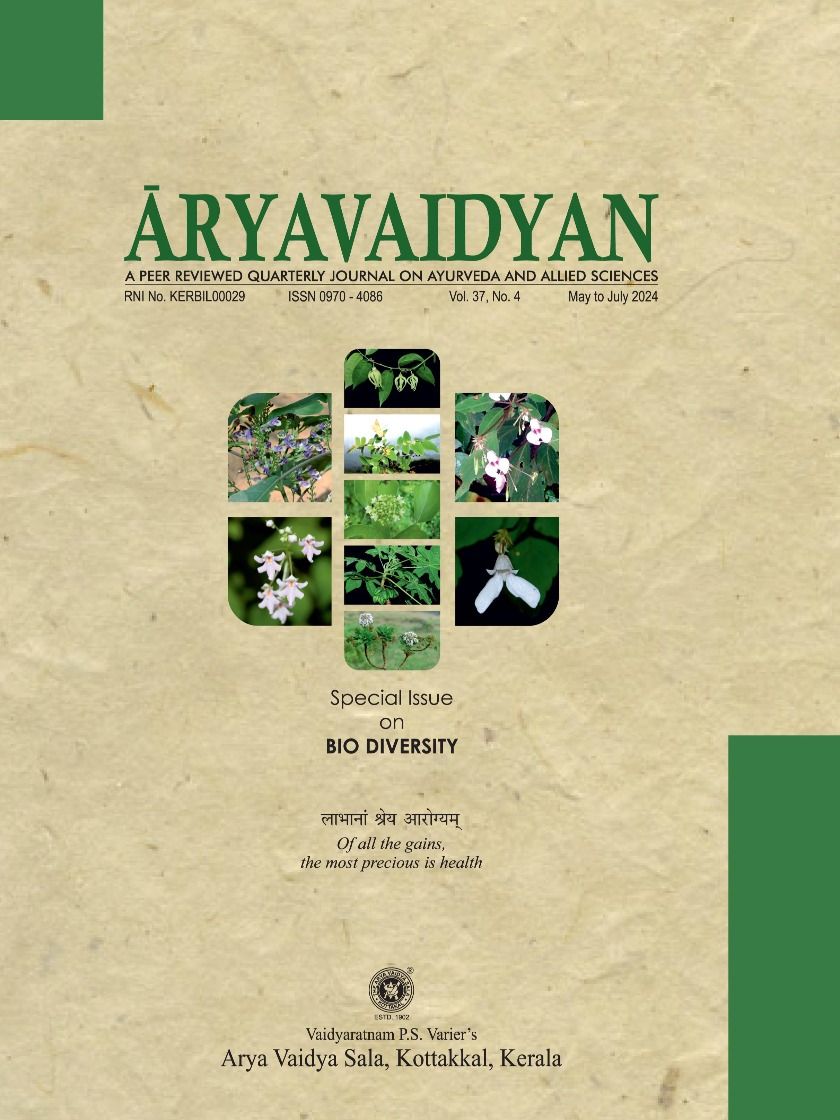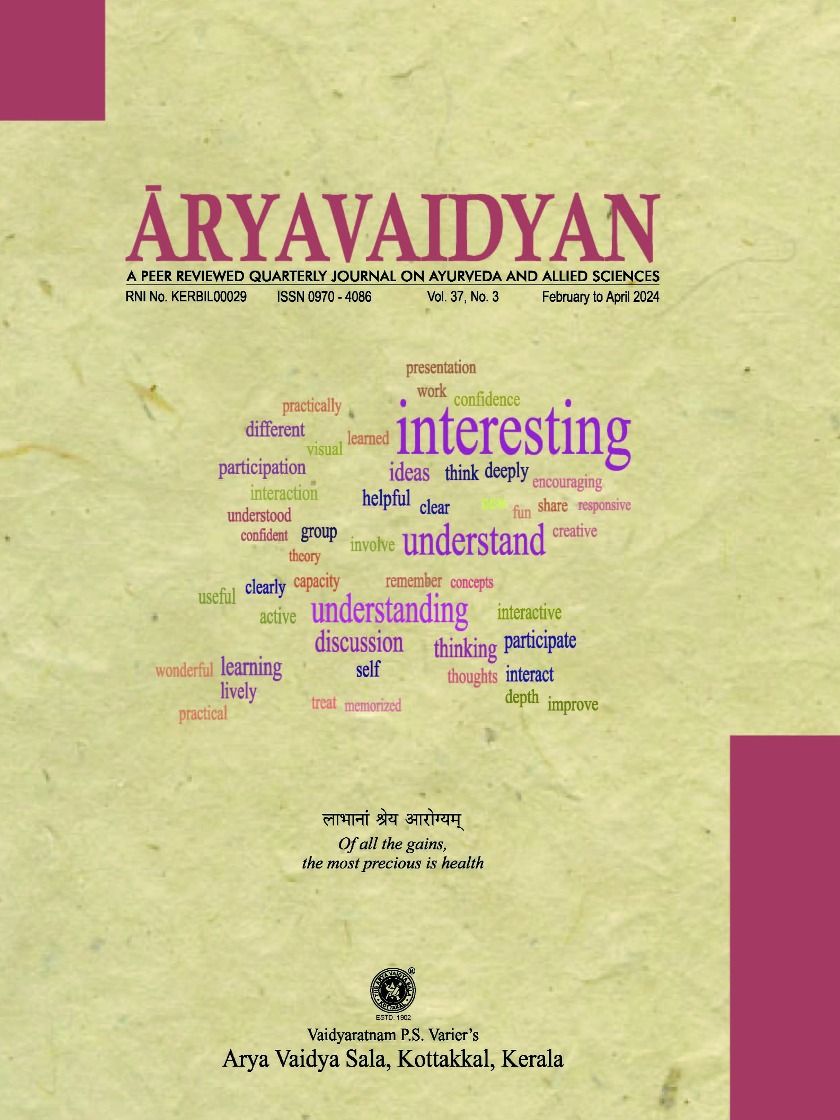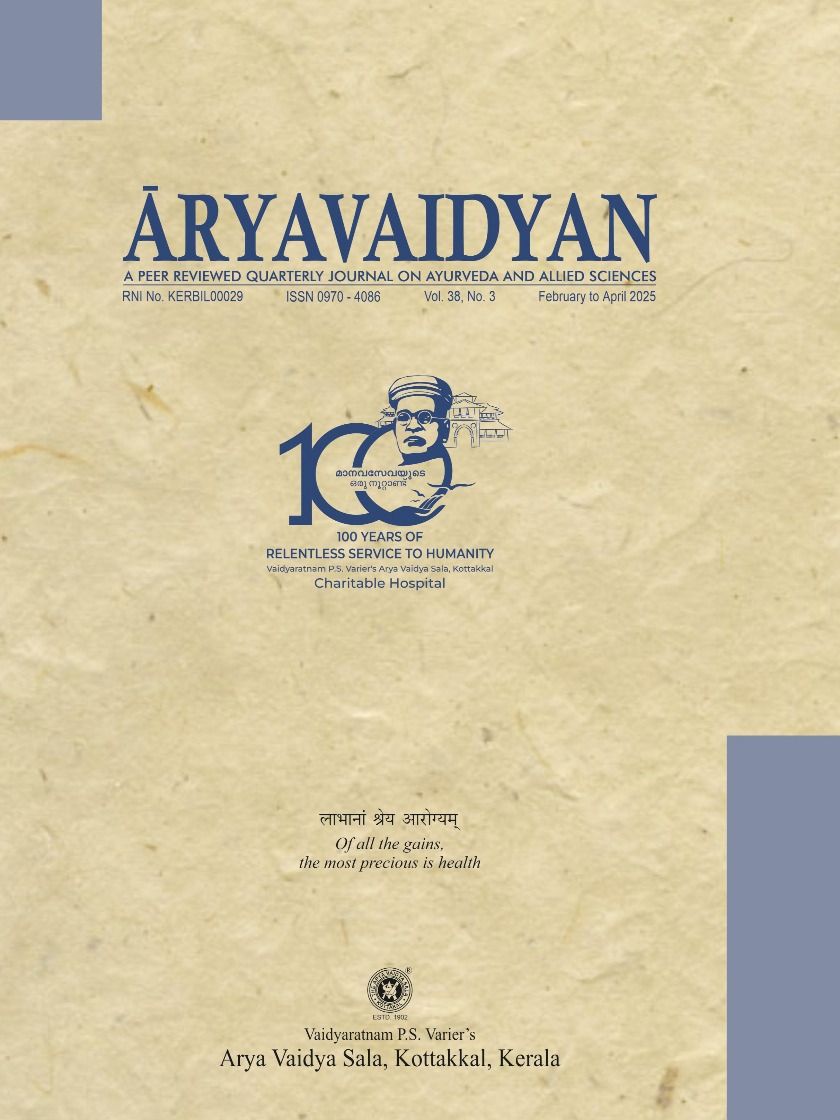
Contents
- Lekha K Warrier
- General
- Sep 26, 2025
The Charitable Hospital - A Saga of Service
- Nagabhushanam Gandla
- Ayurveda Literary Studies
- Sep 27, 2025
Psycho-Socio-Medical Perspective of Aacaara Rasaayana – An Explorative Review
- DIVYA JAIN
- Ayurveda Literary Studies
- Sep 27, 2025
Rasaayana Medicines of the Sus̲ruta-Samhitaa - An Insightful Review
- Rajmohan . V
- Rasayanacikitsa
- Jul 23, 2025
Scientific Validation of Ayurveda Rasayanas: A Review of Experimental Models and Evidence-based Insights.
- Anandaraman Sharma PV
- Pancakarma
- Sep 27, 2025
Exploration of the Rasaayana Potential of Pancakarma
- P M Varier
- Rasayanacikitsa
- Oct 22, 2025
Khadira-Saadhita - Tuvaraka taila as Rasaayana in Psoriasis - A single case experience
- RESHMI KRISHNAN
- Kayacikitsa
- Oct 09, 2025
Sustained Remission in Crohn’s Disease with Rasaayana – A Case Report
- Rati Vijayan
- Pages from Dhanvantari
- Oct 10, 2025
Rasaayanam
Editorial
Scope of self-experimentation in ayurvedic research-inputs from P.S.Varier’s Rasaayana experience
Murali K.*
INTRODUCTION
Self-experimentation is a type of research where the subject and researcher are the same
person.[1] In the field of medicine, a single person designs the protocol, implements it in his
own body, analyses, and reports the outcome. It is not accepted as a specific methodology
due to obvious reasons. Lack of control, potential for bias, the placebo effect and ethical
concerns are the drawbacks. But it has the pros like personalization, rapid results and more
insightful outcomes. There are several reported works involving self-experimentation. Barry
Marshall’s experience with Helicobacter pylori is the often-quoted Nobel Prize-winning
example.[2]
But such reporting is not seen in ayurvedic clinical research, where there is an actual
relevance. Many of the diseases are described with so many subjective symptoms. Emotions
and even dreams are considered indicators of disease. These can be better assessed in self experimentation.
Perception of the treatment is also analyzed in a better way. Individually
suited treatment protocols can also be designed. But surely are problems in its implementation
in all the cases.
This article highlights the self-experimentation with rasaayana reported by P.S.Varier,
which is probably the first instance of such a case. It is inspiring and historically significant.
It is also compared with that of Madan Mohan Malaviya, though the latter one is not self experimentation
but has the commonness in the study of rasaayana.
P.S.Varier (1869-1944), Founder of Arya Vaidya Sala (AVS), Kottakkal, introduced to
the practice of ayurveda, several innovations in the areas of drug manufacturing, health
delivery and ayurvedic education.[3] He was honored by the British authorities with the
title “Vaidyaratnam” for his achievements. Varier also had enough exposure to allopathic
medicine, from which he tried to imbibe the specific structured and organized approach,
essential for every knowledge system.
The colonial period during which P.S. Varier lived, witnessed a very challenging phase
for ayurveda. The indigenous medical system faced relegation and sidelining as allopathic
medicine was officially promoted. With the lack of State patronage, the public perception
also started shifting in favor of the foreign treatment system. It is the nationalist movement
that gave a push to preserve and promote indigenous traditions, including ayurveda.
Noted historian Dr. K.N.Panikker summarizes the revitalization of indigenous medicine in
three spheres[4] a. The retrieval, systematization and dissemination of knowledge. b. The
creation of institutional facilities for training physicians. c. The preparation and distribution of medicine. P.S. Varier contributed significantly to all these in the State of Kerala by
publishing Dhanvanthari magazine (1903), establishing Arya Vaidya Sala (1902) and
initiating a teaching institution, namely Aryavaidya paathasaala (1917).
He maintained an open, critical and eclectic mind throughout his life. Many of his initiatives
were realized after thorough planning and strategizing. The quality of many of the medicines
was assured by his own use or that of the closer ones. Varier also attempted to document
his clinical experiences. In the first publication of AVS, ‘Chikitsasangraha’ (1903) his
impressions on many of the formulations can also be read. He was also very eager to respond
to any criticisms of ayurveda.
In this context, it is noteworthy to revisit
P.S.Varier’s narrative documentation on the
personal experience of undergoing rasaayana.
It was published in Vaidyasarathy Ayurveda
magazine under the editorship of Vayaskara
N.S. Moss (1912-1986) in 1939.
One of the notable documented rasaayana
treatments in the modern era is that of Pandit
Madan Mohan Malaviya (1861-1946).[5] As
a scholar, educationist and nationalist leader,
he was also involved in the Renaissance
movement during the colonial period. Pandit
was a Sanskrit scholar by family tradition.
He also graduated in Sanskrit from Calcutta
University. Therefore, it is natural to have an
interest in ayurveda. In the year 1933, at the age
of 73 years, Pandit was affected by Parkinson’s
disease and stiffness of the neck along with
blurred vision. He thought of undergoing
rasaayana therapy in the kuteepraavesika
mode. When consulted, the Professor ofayurveda at Banaras Hindu University did
not recommend kuteepraavesika. But due to Pandit’s earnest desire, he consulted one Tapsi Baba, a saintly person specialized in
rasaayana. A building as specified in the texts for kuteepravesika was constructed. Aamalaki
rasaayana was administered with a very strict regimen. Light in the building was restricted,
and even cold water was not allowed; No bath or shaving. Only milk was permitted as a
food. The heavy dose of the rasaayana was not tolerated by Pandit. It was reduced after
repeated requests.
In the initial ten days, there were significant positive changes. Madan Mohan Malaviya gained
weight; he thought his memory had improved, some of the old slokas that he had learnt in
school, he could remember; he felt his vision had improved. But these were not sustained,
and after the stipulated 40 days, there are several reports that his health deteriorated. But still, contrasting reports are available from diff erent
sources. Even the dramatic improvement
initially reported is not true, according to the
‘Life of Madan Mohan Malaviya’ published
by the Banaras Hindu University.
Vaidyaratnam P.S. Varier was well aware of the
experience of Malaviya. It was this incident
that prompted him to undergo rasaayana. He
noted his experiences in his diary every day
till the completion of the therapy. Finally
wrote an article out of it and got it published
in the then-popular Ayurveda magazine from
Kerala. Photos before and after rasaayana
were also given in article.
ORIGINAL ARTICLE OF P.S.VARIER[6]
Pandit Malaviya has recently undergone the
rasaayana treatment. But he did not get the
desired eff ect owing to the inability caused in
observing the rigid restriction, abstinence and
in using the prescribed doses of the medicine.
Yet, the trial of Panditji, all of a sudden
attracted my mind to this method of treatment. So I decided to make a trial of the rasaayana
treatment.
It is difficult to get physicians who can give practical aid in this method of treatment properly.
It is even more diffi cult to get persons who have got the fi rmness of mind and capacity for
observing the necessary restrictions in this connection. So I spent as few days considering
what other ways I could fi nd. At last I felt, why I, who have been practising in the fi eld of
medical science for about half a century; could not test this myself ? Why is it not possible
for me to observe properly the necessary restrictions ? How can I know if others do not
adhere strictly to pathyam ? Will it not be a blunder if anything is kept a secret and will
not all work done become fruitless ? These were the things which I thought over. Finally I
decided that it is better to practise it on my own body before trying it on another’s. For this
purpose I selected for use the ‘Brahmarasayana’ itself by using which many ancient rshis
have acquired long life and health and which was invented by Brahma himself. I selected
myrobalan (katukkai-Mal.) Goosebery(nellikkai-Mal.) and the other ingredients in the
proper season and prepared the rasaayana.
I had to work with great earnestness in various ways, to avoid the condition of Arya Vaidya
Sala going down due to the rise of famine from 1930 onwards. Amidst these activities I began
writing and sending through the press “Brhacchaareeram” and do other kinds of works.
In short, I have to work with steady mental application for about more than eight hours
daily. Moreover, I have to suff er bodily weakness, due to my journey to Calicut and Palghat and irregularity in daily routines. Because
of all these things I began to feel weak both
in body and mind. About December 1938
my weakness grew to a great extent. So I
felt a rejuvenation an immediate necessary
and decided to use the rasaayana from the
beginning of January onwards. It was then
that I was compelled to preside over the
medical conference at Tellicherry. When that
was also over my condition grew worse that I
could not do any work due to weakness. So I
entrusted all things to the Assistant Manager
who is also a physician and began using the
medicine.
On January 21st1939 I tasted a small
quantity of this Rasayana which was not very
distasteful. On 22nd I used a greater quantity.
Yet there was no trouble. On 23rd I began to
use the Rasayana regularly according to the
prescriptions. The house in which I reside is
built in a manner which is suited for using
rasaayana . So I had not the need to go to
another place for this purpose.
My daily routine was this-
• At 7 a.m. in the morning after answering
the calls of nature and the subsequent
cleansing I would use quarter of a pound of
the Rasayana and after that a cup (8 oz.) of boiled warm cow’s milk. Then I would lie on
my left side for three hours.
• At 10 a.m. I would spend some time for prayer. After that I would examine serious cases of patients and would prescribe medicines.
• At 11 a.m. (the time at which I used to take meal) I would drink either one or one and a quarter
cups of milk and would lie.
• At 2 p.m. I would dictate from inside and get the replies of important letters written.
• At 3.30 p.m. I would take in 5 tolas of the Rasayana and a cup of milk and would lie down.
• After 5.30 p.m. I would examine patients if any.
• If there is no frost, cold or wind I would step outside and walk slowly up to one mile.
• On return I would drink a cup of milk.
• At 8 p.m. I would have an oil bath on alternate days.
• At 8.30 p.m. I would take rice meal observing pathya, made from 10 tolas weight of wheat, At 9
p.m. I would go to bed.
Amongst these, walking out, examining patients,
mental application for writing replies and such
are naturally forbidden. Yet, I did in that manner
not to disappoint patients and since it was me of
my trials did in that manner with great caution
and care.
Anyhow no harm occurred on account of that.
Since the dose of Rasayana was larger at
the beginning, I felt some heaviness and
uncomfortableness in the stomach and a
vomiting sensation. Yet these troubles gradually
decreased and there was no obstruction for sleep
or motion.
Changes in the body
After using the Rasayana for one week the
wrinkles on the body which had appeared on
account of old age slowly began to disappear.
Weakness gradually disappeared and I began
to obtain vigor. Though at first I had decided to
make this trial only for one week; yet I did not stop
it. Since bodily and mental comfort increased
excessively I used the medicine for twenty one
days regularly under the same conditions. I did not expect at first that there would be so much
effect. As I had made arrangements only for forty
days’rest, I had no other go except to stop for the present though I did it with much regret. I stopped the medicine for one day when I found I do not get
so much ease as I got while using the rasaayana. Hence I began to use it again; but reduced the dose.
I used only ten tolas of Rasayana for both times inclusive. Since I felt great hunger when I reduced
the dose and began to eat at 11 .00a.m. a rice meal made of eight tolas of wheat. About March 5ththe
second duration of pathya (marupathyam) also was over. I think that the changes which have come
in my present and old condition of the body viz. disappearance of the wrinkles, muscles becoming
more rigid, etc. can be understood by the photographs given. Regarding the state of the mind I felt at
present extra ordinary happiness and buoyancy. Yet, I am not without regret for having had to stop
the medicine so soon. But I have consolation that I can undergo once more the rasaayana treatment
without much delay after making sufficient preparations. That greatness of the ancient ayurvedic
aacaaryas who found out such medicines is indeed transcendent.
DISCUSSION
Madana Mohan Malaviya did not get the full-fledged effects of rasaayana for many reasons. He
was affected by several diseases, such as Parkinson’s disease. He also could not follow the dose and
regimen in its entirety. Age was also another factor. But P.S.Varier was not affected by any chronic
illnesses, but with only ageing.
It must be noted that the awareness of Madan Mohana Malaviya’s experience did not stop P.S.Varier
from taking rasaayana. As an experienced physician, he had a very firm trust in the system of
ayurveda. No separate building was used since his residence ‘Kailasamandiram’ was constructed in
such a way that there are rooms with no excess light or wind. This, in effect, equals a rasaayana-kuti.
Varier himself decided the dose and regimen, which is systematic but also practical. He adjusted
the dose even during the course according to his agni-bala. The regimen was also personalized not
blindly adhering to the texts.
According to the personal diary of P.S.Varier preserved at AVS, the rasaayana started on 22nd
January, 1939, and was completed (including the ‘pathya-alone’ period) on 9th March 1939. It is the
Kerala tradition of practice that after the intake of any medicine, pathya-apathya (dos and don’ts) is
to be followed for a certain number of days. This is more strictly adhered to after pancakarma and
rasaayana treatments. In Malayalam, it is called marupathyam. (Literally, ‘maru’ in Malayalam
means opposite or next) Vaidyartanam Varier took the medicine for 21 days; so he adhered to
marupathyam for the very same number of days.
He tried to assess the effects of rasaayana with whatever measures were available and known to the
times. Body temperature, pulse rate, bowel movements and micturition were monitored every day by
himself. The mental feeling was recorded. After the total completion, P.S. Varier was relieved of the
fatigue he had been having for a very long period. The perception of taste and appetite improved a
lot. Mental capabilities were enhanced.
The analysis is not complete without reviewing his life after the rasaayana. During 1940-41,
P.S.Varier was affected with ardita, which was treated with pratimarsa-nasya, abhyanga, etc., and
had a good recovery. During February 1942, he experienced a short spell of pakshaaghaata that was
relieved spontaneously within minutes. In terms of health, the year 1943 was uneventful. In January
1944, he had a fatal respiratory illness. On 30th January, at the age of 75, he breathed his last during
sleep in a very calm way.
Rasaayana is suggested in the earlier or middle ages. But because of the hectic schedule of life,
P.S.Varier could not get time to take care of himself. Yet he could avail the benefits of rasaayana to
a certain extent.
P.S. Varier’s brave attempt in using rasaayana can be considered as the first instance of selfexperimentation
in ayurveda. This method has true relevance in ayurvedic clinical research. For
example, ayurvedic physicians who are diabetic can adhere to a designed protocol. They can do
their work as usual, assess the outcome variables themselves and document. These can be collected
by the senior one and reported after proper collation. Incidents like COVID can also be a chance for
self-experimentation. The affected doctors can treat themselves systematically and report. Though
each case is with different medications the sum total will surely contributing.
References
1 Weisse AB. Self-experimentation and its role in medical research. Tex Heart Inst J. 2012;39(1):51-4. PMID: 22412227;
PMCID: PMC3298919.
2 Barry Marshall Journal of Gastroenterology and Hepatology Vol. 6 Issue.1 April 1991
3 Binitha, Palengara; Nair, Parvathy G; Krishna Kumar, Venugopal. Vaidyaratnam P. Sankunni Varier (P.S.Varier)- A life
that gave Ayurveda a modern face. Journal of Research in Ayurvedic Sciences 8(Suppl 1):p S14-S19, May 2024. | DOI:
10.4103/jras.jras_337_23
4 Panikkar K.N. Indigenous medicine and Cultural hegemony lecutres on Ayurveda, Arya Vaidya Sala Kottakkal 2002
Jan, pp 01-41
5 Newcombe S. Yogis, Ayurveda, and Kayakalpa: The Rejuvenation of Pandit Malaviya. History of Science in South
Asia. 2017;5(2):85-120
6 P.S.Varier : My Rasayana Treatment Vaidyasarathy An Anglo Sanskrit Monthly Medical Journal Vol. IV No.2 May
1939 pp 29-32
OBITUARY
An Abiding Legacy
Panniyampally Raghava Varier was a person whose heart, soul and thinking process were constantly in resonance with the institution, Arya Vaidya Sala, Kottakkal. This relationship was truly organic and in many senses multi-faceted, going by the many Departments / Activities he has handled efficiently, during his long career of over 6 decades in the institution, spanning from 1st March, 1958 (date of joining Arya Vaidya Sala) till the date of his demise, 12th July, 2025. His activities ranged from construction, plant modernization in the factory, a part of the Materials Department, viz., Sambharanam, related purchases, supervising the management of celebrations and functions, management of Kailasamandiram affairs, opening of Branches and Hospitals in distant and nearby places, leading PSV Natyasangham (from 1965 onwards) to heading the price review and revision,being an active member of the Board of Trustees, etc. In his demise, the institution is bereaved of a versatile Manager, who had deep and pragmatic insight into the affairs of all that he dealt with.
P. Raghava Varier was borne on 26th June, 1935, as the son of Parvathy Varassiar (AKA Kunjukutty Varassiar) and Cherunellikkat Rama Varier, who himself was a trustee of the institution, as nominated under the Will of the great founder, Vaidyaratnam P.S. Varier. Rama Varier, in his own right, was a self-taught expert in Construction, Land Management, Real Estate acquisition, Agriculture, Financial matters, Litigation, etc. His son, Raghava Varier, inherited a lot of these qualities and developed these and more through close observations, involved discussions with experts in the related fields and coherent thinking.
Raghava Varier's knowledge in matters related to construction, civil works, etc. were phenomenal. He worked in the institution, during a stage of consolidation and steady growth, when the development of infrastructure was a necessity. In the preface written by the Late Padmabhushan Dr. P.K. Warrier, for the collection of articles written by P. Raghava Varier, “Ormayute Sugandham” (the Fragrance of Memories), P.K. Warrier fondly and thankfully acknowledges the contributions of Raghava Varier in setting up the two Steam Plants in Kottakkal factory. He visited a medicine manufacturing unit in the then Madras to closely observe the functioning of a similar plant. An expert in the field, Mr. Vaidyanathan, was invited to Kottakkal. He set up the two units, with the able assistance of Sri. Varier. Raghava Varier’s contributions to setting up various branches and hospitals are also much notable.
Besides this, his contribution to other areas of activities are also vividly described in the preface of the book, which is indeed a readable and fascinating work. Dr. P.K. Warrier also mentions that this book gives a bird’s eye view of the affairs of the institution and the world as a whole during the last seven decades.
Raghava Varier also managed Sambharanam, then Department engaged in the procurement and storage of raw materials of non-herbal nature, with notable élan. In this capacity and as an expert of all that is related to the institution, he also looked after Purchase activities in connection with raw materials.
He was also a member of the Trust Board of Arya Vaidya Sala for about four decades.
The author has admired his depth of understanding, skill of comprehension and discernment, in varying areas of management and most surprisingly in the area of finance and costing. While I was looking after the Finance Management of the institution, I have sat with him in many sessions for revision of prices of the AVS products. His quick grasp of financial and cost related matters was amazing. His ability to spend hours together, going through the cost sheets and understanding the elements of costing of each item, was also remarkable. During the intervals in the discussion, our thoughts and conversation very often meandered into current affairs, pertaining to economics, social and seldom politics. Here also his inquisitiveness to know more and more, his grasp of things, etc., were very unique. He also had a penchant for statistics, financial data and MIS statements and he liberally utilized these for arriving at decisions and fulfilling his duties. Raghava Varier headed the Price Review and Revision Committee till his demise.
He was among the handful of persons who have personally met and interacted with the great Founder of Arya Vaidya Sala, Vaidyaratnam P.S. Varier. Raghava Varier’s knowledge about his (Founder’s) vision, capabilities, generosity, care for his employees, love of children, management abilities, clinical and organizing abilities, etc., was really vast. He always burst into spontaneous eloquence while speaking about these. Such protracted interactions with him, were really learning experiences for all of us, who were younger in age.
Another unrelated area where he has excelled with panache, is PSV Natyasangham, which he headed ever since 1965. I have been fortunate to work with him in this area for a short period. As in other fields, his insistence on quality of performance, discipline, maintaining systems, etc. was impressive. As the head of Natyasangham, in his younger days, he accompanied the Kathakali troupe to far off places like Mumbai, Goa, Jamshedpur, Rourkela, etc. and brought about fame and respect for the Sangham.
His role in setting up Branches and Hospitals in distant cities like New Delhi, Madras, etc. and in Kerala, are remembered by many till today.
Another role of his, mentioned in the preface to the aforementioned book, by Dr. P.K. Warrier, is his ability in resolving crises. He remembers several incidents where Raghava Varier’s trouble shooting skills were useful in resolution of problematic situations. We were also witness to many of such episodes.
Another enviable skill that he possessed was that of an astute and shrewd negotiator. The author has been witness to such events. Almost in all such cases his stance finally prevailed. The bargain related discussions obviously always hinged on pruning of cost, without any undercuts on quality of the goods / services delivered.
There were two realms in which he was never willing for any compromises: one was regarding issues related to the interests of the institution, as he viewed them and the second was his pristine admiration of the founder.
A manager who combines his heart, thinking faculties and skills, in good proportions, in the decision making process and execution, should be among the best of the lot. Raghava Varier easily belonged to this rare genre of Managers. The way in which he discharged the many duties and responsibilities entrusted to him and which he himself took up, in the best interests of the institution, is the best evidence for having fulfilled the above dictum.
The examples set by him are indeed the ones that should be followed by the coming generations and truly, this will be the greatest tribute to his abiding legacy.
References:
1) “Ormayute Sugandham”, an anthology of essays written by Raghava Varier about various facets of Arya Vaidya Sala and other matters.
2 ) Discussions with the officiating and retired executives of Arya Vaidya Sala, Kottakkal.
3) Author’s interactions and discussions with Raghava Varier.
- By Rajendran P. , Joint General Manager (CA), Arya Vaidya Sala, Kottakkal
Editorial Board
Chief Editor
Prof. K. Murali
Former Professor, Govt. Ayurveda College, Thrippunithura, Kerala
Sub Editors
Dr. A. Raghunathan Nambisan
Executive Editor
Dr. Devikrishnan K.
Chief Sub Editor
Vd. M Prasad
Member
Chief Consultant, Sunethri Ayurveda Hospital, Trikkur, Thrissur
Dr.Sulaiman C T
Associate Editor
Advisory Board
Dr Madan Thangavelu
Genome Biologist, University of Cambridge, United Kingdom
Dr Lakshmi Pulakkat
Molecular Cardiology Research Institute (MCRI) ; Professor of Medicine, Tufts University School of Medicine; Adjunct Professor of Medicine, University of Missouri-Columbia School of Medicine
Dr. P. Madhavankutty Varier
Patron , Managing Trustee & Chief physician ,Arya Vaidya Sala, Kottakkal
Dr. Naveen Kumar V.V.
Plant Taxonomist, Centre for Environment & Marine Studies, King fahd University of Petroleum & Minerals, Saudi Arabia
Dr. Sunil Kumar Vijaya Gopal,
Senior Research Associate, Lutheran Hospital, Germany
Dr. T. Sreekumar
Emeritus Professor, PNNM Ayurveda College, Cheruthuruthy, Thrissur
Dr. M. Prasad
Director, Sunethri Ayurvedashram & Research Centre, Trikkoor, Thrissur
Dr. J.S.R. Prasad
Professor, University of Hyderabad
Dr. M.V. Vinod Kumar
Professor, VPSV Ayurveda College, Kottakkal
Dr. K. Muraleedharan
Trustee & Additional Chief Physician, Arya Vaidya Sala, Kottakkal
Dr. P. Ramkumar
Trustee & Factory Manager, Arya Vaidya Sala, Kottakkal
Shri Ajay K.R.
Trustee & Factory Manager, Arya Vaidya Sala Factory, Nanjangud
Shri P. Rajendran
Joint General Manager (Corporate Affairs), Arya Vaidya Sala, Kottakkal
Shri K.V. Ramachandran
Consultant, Arya Vaidya Sala, Kottakkal
Dr. Indira Balachandran
Project Director, Centre for Medicinal Plants Research, Arya Vaidya Sala, Kottakkal
Dr. Leena Abraham
Former Professor, Tata Institute of Social Science, Mumbai
Dr. Tanuja Nesari
Director, All India Institute of Ayurveda, New Delhi
Dr. Santhosh S.R. Nair
Chaudhary Brahm Praksh Ayurveda Charak Sansthan, New Delhi
Dr. M.V. Anilkumar
Professor, School of Fundamental Research in Ayurveda, Tripunithura
Dr. Narayanan Nambi
Principal, Ashtangam Ayurveda Vidyapeetham, Vavanoor, Koottanad, Palakkad District, Kerala
